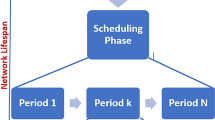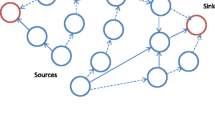Abstract
In Wireless Sensor Networks, collection of data from the sensor nodes without data loss is a major challenge of great concern. Nodes are deployed statically and will relay the data to the base station which lead to the problem of energy-drain to the nodes near the base station since these nodes have to constantly relay data to the base station. Data collection from the sensor nodes by the mobile node or element without data loss is termed as the scheduling of the Mobile Element (ME). The proposed problem can be classified into three phases. In the initial phase, the nodes are clustered according to their geographical region in a hierarchical fashion. In the second phase, the nodes within each cluster which are in the active state are only visited by the mobile element. Quad-tree based partitioning is performed in order to schedule the visit by ME to the nodes in the active state within each cluster. In the third phase, the ME visits only the boundary-near nodes and the speed of the ME is varied based on the simplex method such that the data loss is minimized.





Similar content being viewed by others
References
A. A. Somasundara and A. Ramamoorthy, Mobile element scheduling with dynamic deadlines, IEEE transactions on Mobile Computing, Vol. 6, p. 4, 2007.
C. Liu and Y. Xiao, Random coverage with guaranteed connectivity: joint scheduling for wireless sensor networks, IEEE Transactions on Parallel and Distributed Systems, Vol. 17, No. 6, pp. 562–575, 2006.
K. Indra Gandhi, D. Rajasekar, and M. M. Prabu Shyam, A cluster-based hierarchical approach for scheduling the mobile element in wireless sensor networks. In International Conference on High Performance Computing, 2008.
S. Slijepcevic and M. Potkonjak, Power efficient organization of wireless sensor networks. In Proceedings of IEEE International Conference Communication 2001, June 2001.
Y. Gu, D. Bozdağ, and E. Ekici, Mobile element based differentiated message delivery in wireless sensor networks. In Proceedings of the International Symposium on a World of Wireless, Mobile and Multimedia Networks, 2006.
K. Indra Gandhi and P. Narayanasamy, Energy-aware mobile element scheduling in wireless sensor networks. In International Conference on Sensing Technology, ICST, December 2008.
H. A. Taha, The simplex method. In Operations Research an Introduction, pp. 59–98. Prentice Hall, India, 1996.
R. Dondo and C. Cerdá, A cluster-based optimization approach for the multi-depot heterogeneous fleet vehicle routing problem with time windows, European Journal of Operations Research, Vol. 176, pp. 1478–1507, 2007.
Y. Zhong and X. Pan, A hybrid optimization solution to VRPTW based on simulated annealing. In Proceedings of the IEEE International Conference on Automation and Logistics, August 18–21, 2007.
K. Indra Gandhi, D. Rajasekar, and M. M. Prabu Shyam, Towards energy-efficient and guaranteed network coverage via quad-tree based partitioning in wireless sensor networks. In Proceedings of International Conference on Sensors, Security, Software & Intelligent Systems (ISSSIS) 2009, Coimbatore Institute of Technology, Coimbatore and Oklahoma State University, USA, January 8–10, 2009.
Author information
Authors and Affiliations
Corresponding author
Additional information
A preliminary version of this paper has appeared in the proceedings of the International Conference on Sensing Technology, ICST 2008, Taiwan.
Rights and permissions
About this article
Cite this article
Indra Gandhi, K., Narayanasamy, P. A Cluster-Based Quad-Tree Partitioning for Scheduling the Mobile Element in Wireless Sensor Networks. Int J Wireless Inf Networks 18, 50–55 (2011). https://doi.org/10.1007/s10776-010-0119-8
Received:
Accepted:
Published:
Issue Date:
DOI: https://doi.org/10.1007/s10776-010-0119-8




